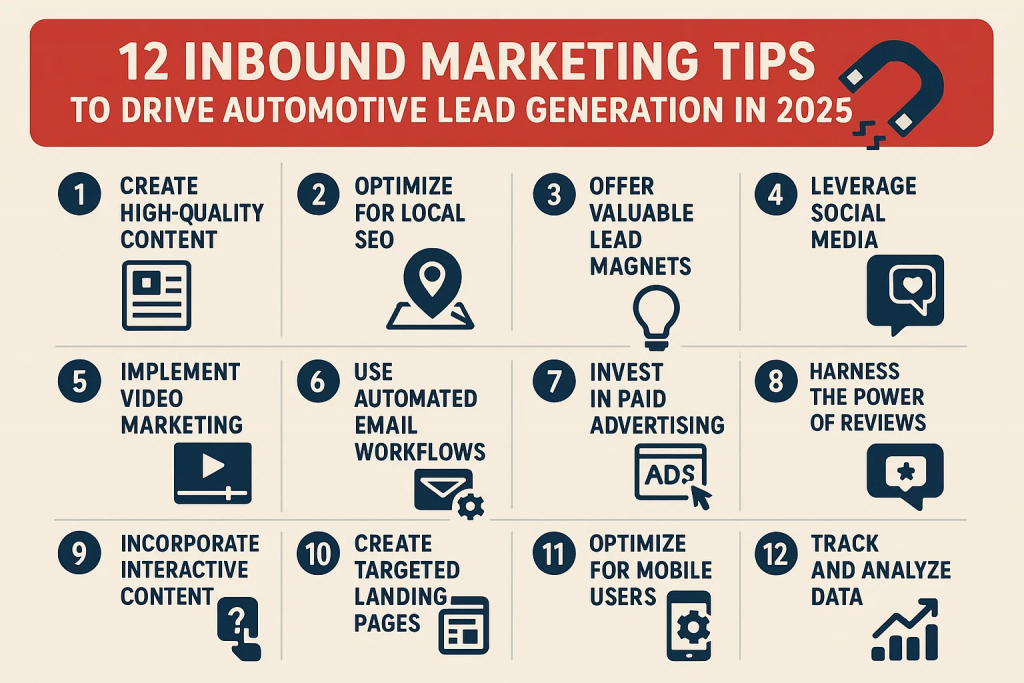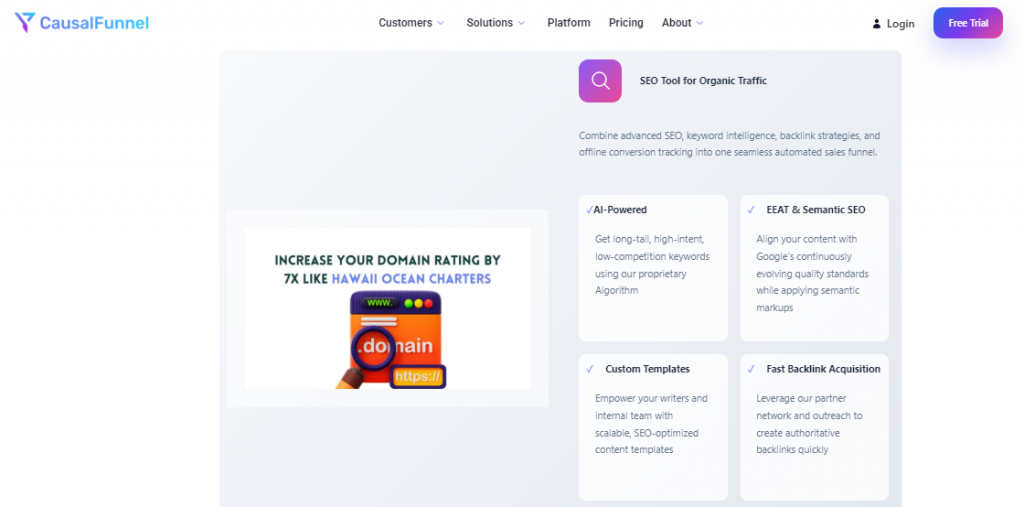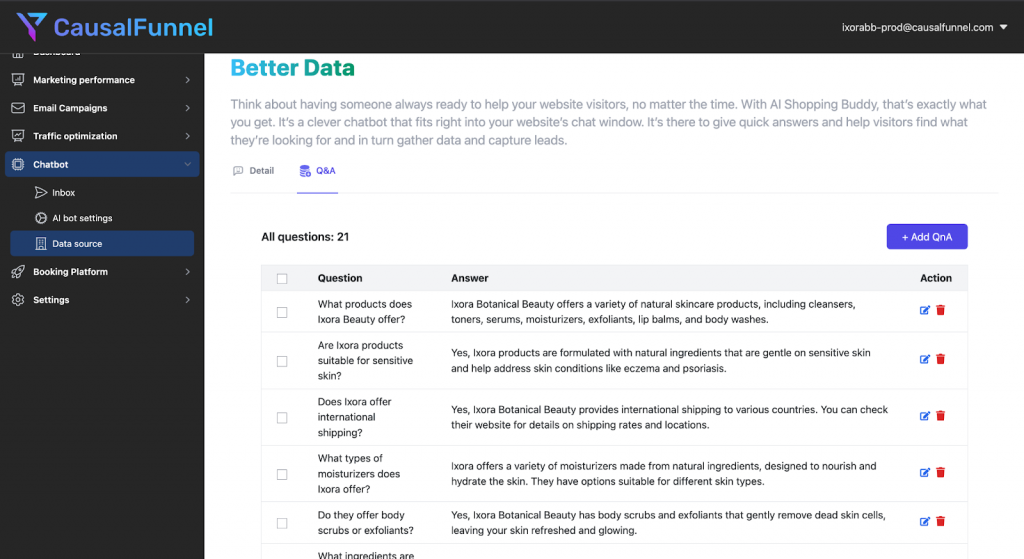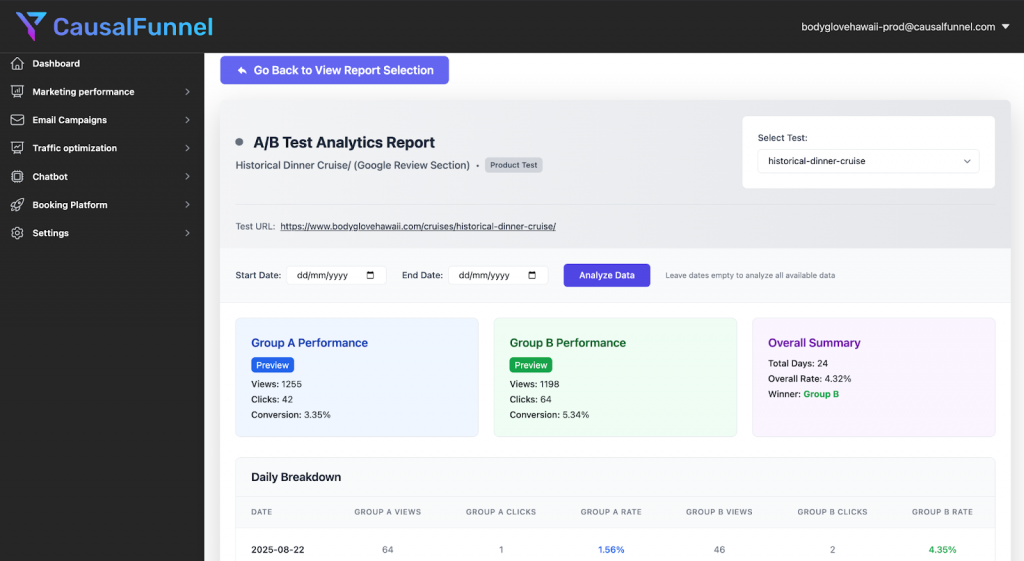Are you spending too much on ads and are only seeing small returns? You’re not the only one facing this challenge today.
Car buyers have changed how they shop for vehicles. They research online before visiting your dealership. They compare prices, read reviews, and watch videos from home and form an opinion accordingly.
Automotive inbound marketing offers a better solution than traditional advertising. Instead of pushing ads, you attract buyers with helpful content that has more impact. This approach may include blog posts, videos, guides, and social media insights that address the needs and questions of car buyers.
By educating and engaging prospects rather than interrupting them with unsolicited ads, dealerships can build trust and credibility. Over time, this approach accelerates automotive lead generation by attracting more qualified leads. Additionally, it fosters stronger relationships with customers, increases brand loyalty, and ultimately improves conversion rates.
This approach costs less and brings better quality leads. Studies show 95% (Research Source) of car buyers use digital tools during their search. Another 62% (Research Source) prefer online research over dealership visits.
This guide shares 12 proven tips to improve your automotive lead generation. You’ll learn strategies that work for dealerships of all sizes. These tactics help you attract more qualified buyers without wasting money.
In this guide, you’ll discover:

Traditional car ads interrupt people during their favorite TV shows. Inbound marketing works differently by providing value when buyers need it most.
Modern car buyers research extensively before making contact with dealers. They visit websites, watch videos, and read reviews multiple times. The average buyer checks 8-12 online sources before deciding.
Inbound marketing costs significantly less than traditional advertising methods. You create content once, and it keeps working for months. Paid ads stop working the moment you stop paying for them.
Today’s buyers follow a clear path when shopping for vehicles. Understanding this journey helps you create better marketing content.
Inbound marketing generates leads at $20-50 per lead on average. Traditional outbound methods cost $100-200 per lead or even more. That’s a 60-75% reduction in cost per lead.
Lead quality matters more than just quantity in automotive sales. Inbound leads actively searched for your content and chose to engage. They’re already interested before you make contact with them.
Your website and blog content work 24/7 without additional costs. This creates long-term value that compounds over time with better results.
Educational content attracts buyers when they’re researching vehicle purchases online, making it a powerful tool for automotive lead generation. Your blog establishes your dealership as a trusted expert resource.
Consistent blogging improves your search engine rankings significantly over time. Google favors websites that regularly publish helpful, relevant content for users. Car buyers often search with questions, making blog posts perfect answers.
Best Blog Topics for Car Dealerships:
Pro Tip: Use AI-powered SEO keyword tools to discover what local buyers are searching for. Long-tail keywords like “best used trucks under 30k near me” may have lower search volume but attract highly qualified prospects ready to buy.
Tools that combine SEO insights, keyword intelligence, and performance tracking like CausalFunnel’s Organic Traffic platform that makes this process seamless and data-driven.
Action Items:

Local searches drive massive traffic to automotive dealerships in every market. When buyers search “car dealers near me,” you want top placement.
Google’s local pack shows three businesses at the top of results. Getting featured here dramatically increases your automotive lead generation numbers. Studies show 76% of mobile local searches result in store visits.
1. Google Business Profile Optimization: Fill out every single field completely. Add high-quality photos of your inventory and facility regularly. Post weekly updates about new arrivals and special offers. Ask satisfied customers to leave honest reviews about their experience.
2. Location-Based Keywords: Include your city and neighborhood names naturally in content. Add them to page titles, meta descriptions, and throughout your website. Don’t force them awkwardly, keep it natural and helpful for readers.
3. Local Landing Pages: Create separate pages for each location you serve nearby. Write unique content for each page, never duplicate the same text. Show inventory specific to that location when possible for relevance.
4. NAP Consistency: Keep your Name, Address, and Phone identical everywhere online. Check business directories, social media, and your website for consistency. Even small differences can confuse Google and hurt your rankings.
5. Local Link Building: Partner with other local businesses for mutual promotion opportunities. Sponsor community events and get listed on event websites. Join your local chamber of commerce and related business organizations.
Did you know? Businesses with complete Google profiles get 70% more location visits than incomplete ones.
3. Leverage Social Media to Build Trust and Engagement
Social media helps you build relationships before buyers visit your dealership. Organic social reach costs nothing but time and creative effort.
Authentic content on social platforms builds trust with potential buyers naturally. People prefer buying from businesses they feel connected to personally. Regular posting keeps your dealership top-of-mind when buyers are ready. Research shows 78% of consumers trust peer recommendations on social media.
Facebook: This platform offers the largest and most diverse user base. Share customer testimonials, new inventory arrivals, and community involvement stories. Use Facebook Marketplace to list individual vehicles for direct discovery. Join and participate in local community groups to build awareness.
Instagram: Visual storytelling works perfectly for showcasing beautiful vehicles and happy customers. Use Stories for behind-the-scenes content that humanizes your dealership team. Create Reels highlighting vehicle features with trending audio for maximum reach. Post carousel galleries comparing different models or showing vehicle details closely.
YouTube: Long-form video content performs exceptionally well for car shopping research. Create virtual test drive videos, maintenance how-tos, and detailed walkthroughs. YouTube functions as the second-largest search engine after Google itself. Your videos appear in Google search results alongside text content.
LinkedIn: Focus on business-to-business opportunities like fleet sales and leasing. Connect with local business owners who make company vehicle purchases. Share industry insights and thought leadership to establish dealership credibility.
Action Steps:
Post consistently 3-5 times per week minimum
Respond to all comments within 2 hours
Share content from satisfied customers with permission
Use platform-specific features like Stories and Reels

Modern buyers expect instant responses when browsing your website at night. Response speed directly impacts your automotive inbound lead generation success rates.
Studies show leads contacted within 5 minutes are 21 times more likely to convert. Traditional phone and email responses often take hours or even days. Live chat meets buyers at their moment of highest interest.
Live chat provides 24/7 availability even when your team goes home. CausalFunnel’s AI chatbots handle initial questions and collect contact information automatically. When conversations get complex, the system transfers to human sales agents. Integration with your CRM system keeps all lead data organized.
Key Benefits:
Instant engagement: Capture interest while buyers actively browse your inventory
Qualification automation: AI asks questions and scores leads automatically
After-hours coverage: Never miss weekend shoppers or evening browsers
Multilingual support: Serve diverse communities in their preferred language
Data collection: Gather contact details naturally through beneficial conversation
1. Trigger timing: Launch chat after 8-10 seconds on vehicle detail pages. Don’t interrupt immediately; let them browse first briefly.
2. Welcome messages:Use a friendly, casual tone like “Looking for your next car?” Avoid corporate-sounding greetings that feel impersonal to modern buyers.
3. Button options: Offer specific pathways rather than open-ended questions initially. Examples include Browse Inventory, Schedule Test Drive, or Determine Trade Value.
4. Human escalation: Transfer to live agents for complex questions quickly. Hot leads showing high interest should speak with real people.
5. Create Compelling Video Content for Virtual Showrooms
Video content increases conversion rates by up to 80% compared to text alone, making it a highly effective strategy for automotive lead generation. The pandemic accelerated virtual shopping preferences that continue today strongly.
YouTube serves as the second-largest search engine globally after Google. Your dealership videos appear in both YouTube and Google search results.
Virtual Test Drives: Show 360-degree interior tours with complete exterior walkarounds
Vehicle Comparison Videos: Demonstrate features side-by-side for easy decision-making
Customer Testimonials: Let real buyers share authentic experiences in their words.
Maintenance How-Tos: Build long-term relationships with educational service content
Staff Introductions: Help buyers feel comfortable with your team before visiting
Behind-the-Scenes: Show your service department quality and detailing process
Implementation Tips
Start with your smartphone camera if the budget is tight initially. Video quality matters less than helpful, authentic content for your audience. Keep most videos between 1 and 3 minutes for best engagement rates.
Optimize videos for search with descriptive titles and keyword-rich descriptions. Add transcripts to help search engines understand your video content. Embed videos on your website, upload to YouTube, and share across social media.
Always include clear calls to action (CTA) at the end of videos. Tell viewers exactly what to do next after watching.
6. Offer Valuable Lead Magnets and Downloadable Resources
Lead magnets exchange valuable content for contact information from interested buyers. This approach feels helpful rather than pushy to modern consumers.
The value exchange builds trust before any sales conversation happens. Buyers appreciate receiving useful information they can use immediately. Lead magnets also enable nurturing sequences that convert over time.
Effective Lead Magnet Ideas for Dealerships
Buyer’s Guides: “Complete Guide to Buying Your First Electric Vehicle”
Pricing Calculators: Interactive tools estimating monthly loan or lease payments
Trade-In Valuations: Instant online appraisal tools for current vehicles
Maintenance Checklists: Seasonal car care PDFs owners can print
Comparison Sheets: Model specification charts for easy side-by-side review
Warranty Guides: Help buyers understand extended warranty decision factors
Financing Ebooks: “Understanding Auto Financing Options in 2025”
New Model Previews: Early access information about upcoming inventory arrivals
Conversion Optimization
Keep forms short with only 2-4 fields maximum for higher completion. Ask for name, email, phone, and vehicle interest at most. Make forms mobile-friendly since most buyers browse on smartphones today.
Deliver lead magnets immediately through automated email after form submission. Follow up with a 3-5 email sequence over two weeks. Each email provides additional value while gently moving toward a sale.

For example, using an A/B testing platform, a dealership tested two versions of a “Schedule My Test Drive” button and discovered that changing the text and color increased clicks by 27%. Landing pages focus on a single conversion goal without distractions.
Unlike homepages with multiple paths, landing pages drive specific actions. Optimized landing pages can improve conversion rates by 200% or more.
Use dedicated landing pages for PPC campaigns, email promotions, and social ads. Each traffic source should lead to a relevant, tailored page. Platform-driven tools help analyze user behavior and continuously improve page performance.
Essential Landing Page Elements
Quick Wins Checklist:
Email marketing delivers a $42 return for every $1 spent on average. This makes it one of the highest ROI channels available. Email nurturing builds relationships over time rather than forcing immediate sales.
Personalized emails perform significantly better than generic mass messages sent broadly. Buyers appreciate relevant content tailored to their specific interests and needs.
Email 1 (Immediate): Send a welcome message and deliver your promised lead magnet. Set clear expectations about future emails and their frequency. Introduce your dealership briefly without heavy sales pressure at this stage.
Email 2 (Day 2): Share educational content like vehicle buying tips or financing guides. Provide pure value without any sales pitch in this message. Include a soft call to action inviting them to browse your inventory casually.
Email 3 (Day 5): Share social proof through customer success stories and experiences. Link to video testimonials from recent buyers if available. Gently encourage them to visit your showroom or schedule appointments.
Email 4 (Day 8): Present a limited-time special offer or exclusive incentive for subscribers. Create urgency without being manipulative or overly aggressive about it. Include a clear scheduling call to action with an easy booking process link.
Email 5 (Day 14): Send a final reminder about the expiring offer to create urgency. Alternatively, request feedback if they’re not interested right now. Use responses to segment your list for better future targeting.
By Source: Tailor messaging based on how they originally found you
Research shows 93%(Source) of consumers read online reviews before making purchases. Trust is relevant enormously for high-ticket items like vehicles and services. Reviews also significantly improve your local SEO rankings on Google.
Negative reviews actually increase authenticity when handled professionally and promptly. Perfect 5-star ratings can seem fake to sophisticated modern buyers.
Feature 3-5 rotating testimonials prominently on your homepage for visibility. Create a dedicated reviews page with filters by vehicle type and rating. Display relevant reviews on individual vehicle listing pages for context.
Integrate the Google Review widget to show real-time ratings directly. Feature video testimonials prominently, as they build the strongest trust quickly. Always respond to negative reviews professionally, showing you care about concerns.
Traditional long forms have 81% average abandonment rates across industries. Multi-step forms reduce cognitive load by showing one question at a time. This approach leverages psychological commitment and consistency principles effectively.
People feel overwhelmed when they see many form fields all at once. One question at a time feels manageable and less intimidating psychologically. Once people start a process, they’re more likely to finish it.
Key Benefits:
Webinars attract high-quality, self-selecting leads who are genuinely interested already. These virtual events provide value while building relationships without pressure. Post-pandemic comfort with virtual events makes this strategy more effective now.
Announce webinars to your email list two weeks before the date. Create social media countdown posts building anticipation and registrations gradually. Build a landing page with a simple registration form collecting basic information.
Send the recording to all registrants within 24 hours of completion. Include resource downloads and relevant links mentioned during the presentation. Schedule follow-up calls from the sales team for highly engaged attendees. Create different nurture sequences for attendees versus no-shows with tailored messaging.
Data-driven decisions consistently outperform gut feelings in marketing effectiveness. The “set it and forget it” approach wastes money on underperforming tactics. Continuous improvement philosophy separates successful dealerships from struggling ones over time.
Monthly Review: Analyze all metrics and identify channels or content underperforming. Search for patterns and correlations that explain why things work.
Hypothesis Formation: Determine what specific changes might improve your current results. Base hypotheses on data patterns rather than random guessing approaches.
A/B Testing: Test one variable at a time, like headlines, CTAs, or images. Run tests long enough to gather statistically significant data samples.
Implementation: Apply winning variations across similar content and campaigns immediately. Document learning for future reference and team knowledge sharing.
Tool Recommendations:
Inbound marketing builds sustainable automotive lead generation that improves over time naturally. The 12 strategies covered here work together to attract qualified buyers. Educational content, SEO, social media, live chat, video, lead magnets, landing pages, email, reviews, forms, webinars, and analytics create a complete system.
This approach builds long-term assets rather than temporary ad spend. Your content continues working 24/7, attracting leads while you sleep peacefully. Lead quality improves dramatically because buyers choose to engage with you. Cost-effectiveness makes inbound accessible for dealerships of every size and budget.
Getting Started Action Plan:
Month 1: Audit your current website, start blogging consistently, and optimize your Google Business Profile.
Month 2: Add live chat functionality, create your first lead magnet, and start email sequences.
Month 3: Launch consistent social media posting, create first video content, and optimize landing pages.
Ongoing: Monitor analytics monthly, run A/B tests regularly, and refine based on data.
Implementation requires effort and consistency over several months of commitment. However, compound returns make the investment worthwhile with exponential growth potential. Your content works continuously, building relationships and generating leads automatically.
Start small, but start today with one or two strategies. Add more tactics gradually as you see results and build confidence.
Inbound marketing attracts customers through valuable content they actively seek. Outbound marketing pushes messages through ads, billboards, and cold calls. Inbound costs 60-75% less per lead on average than outbound methods. Inbound leads show higher quality because they chose to engage voluntarily. Modern buyers strongly prefer researching independently over being interrupted by advertisements.
Expect 3-6 months before seeing significant, measurable results from inbound efforts. Quick wins like live chat can generate leads within weeks. Long-term strategies like SEO and content marketing compound over time gradually. Patience is required compared to the immediate paid ad results you see. However, inbound results sustain themselves long after you create the content.
Inbound marketing typically generates leads at $20–50 per lead, on average. Outbound methods cost $100–200 per lead or even more in competitive markets. These numbers only tell part of the story about true value. Lead quality significantly impacts cost per sale, the metric that truly matters most. Content remains as an asset working continuously, while ads stop working immediately.
Yes, small dealerships often have significant advantages with inbound marketing approaches. Local and personal connections matter more than massive advertising budgets here. Lower budget requirements make inbound feasible for smaller operations. Niche targeting lets you dominate specific segments big dealers ignore. Authentic storytelling resonates more than corporate messaging from large chains.
Begin with website optimization and consistent blogging as your foundational strategy. Add active social media presence as your second priority after that. Layer in email marketing automation as your third step after basics. Prioritize based on your available resources and team capabilities realistically. Avoid trying to implement everything simultaneously, as this causes overwhelm.
Track the original source of every lead in your CRM system. Attribute final sales back to the original touchpoint that started relationships. Calculate total investment, including tools, time, and content creation costs. Compare cost per acquisition across different channels for objective comparison. Remember multi-touch attribution is complex, so use first-touch for simplicity.
Empowering businesses to optimize their conversion funnels with AI-driven insights and automation. Turn traffic into sales with our advanced attribution platform.



